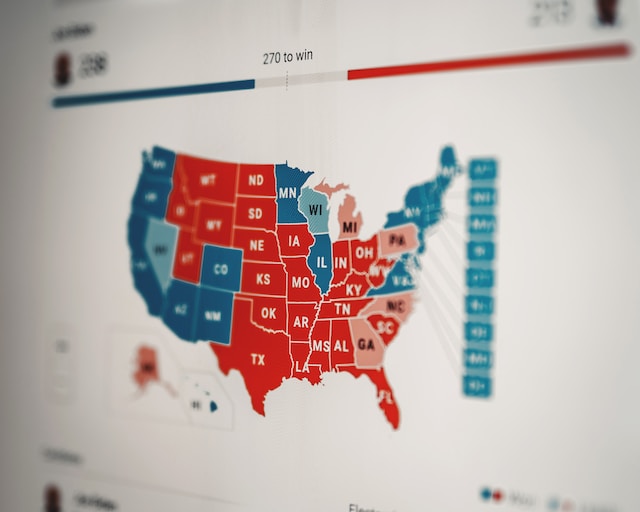Effective data visualization is crucial for conveying complex patterns and trends in today’s data-driven world. One powerful tool that does this perfectly is a choropleth map. Its ability to represent data through colors and spatial divisions makes it indispensable to researchers, geographers, and analysts.
Interestingly, this guide provides essential information on this map by exploring its definition, examples, applications, and how to create it. At the end of this guide, you will better appreciate the importance of choropleth maps in gaining insights from geospatial data.

- What Is a Choropleth Map?
- 5 Benefits of Choropleth Maps in the 21st Century
- How Do Choropleth Maps Use Colors?
- Choropleth Map Examples and Applications Across Different Industries
- Easy Steps To Creating Choropleth Maps
- Thematic Maps and Choropleth Maps: Are There Differences?
- Mapize – The Ultimate Platform for Data Visualization and Interactivity
What Is a Choropleth Map?
We live in a society where detailed information is key to achieving optimal results. Hence, there is a need to distill complex geographical data into a visually appealing and easily digestible format. Choropleth maps rise to the challenge and aid users’ understanding of sophisticated geographic details.
So you are right to ask, “What is a choropleth map?” It is a thematic map that employs color or shading to represent data values within specific geographic areas. These areas can range from countries and states to cities and counties. A choropleth map visually represents spatial variations by dividing a map into discrete regions and assigning colors based on data values.
These maps’ ability to reveal spatial patterns and trends makes them particularly powerful. They reveal information that may be difficult to obtain via other data formats. Thus, as we gaze upon the map, we notice striking contrasts of colors, inviting us to explore the story beneath.
For instance, darker color shades can unveil higher concentrations of wealth, population density, or even environmental pollution. On the flip side, lighter tones reveal areas of scarcity, lower crime rates, and population density.

5 Benefits of Choropleth Maps in the 21st Century
The importance of a choropleth map in today’s data-driven world is worthy of consideration. This map type is a beacon of clarity and inspiration, reminding us that data is more than collecting numbers or recording statistics. It provides a gateway to knowledge and enlightenment. Here are five advantages of choropleth maps in today’s world.
1. Choropleth Maps Help in the Visualization Patterns and Trends
A choropleth map effectively visualizes spatial patterns and trends, allowing researchers and analysts to identify and interpret regional variations. This map uses color gradients to highlight areas with higher or lower values, revealing concentration or disparity across regions. This is often helpful in economics, sociology, and public health.
2. Choropleth Maps Allows Data Comparison
A choropleth map enables easy comparison between different regions, providing insights into relative values and facilitating the identification of outliers. Using consistent classification methods and color schemes, researchers can discern areas with similar characteristics and regions that deviate from the norm. This aids in the identification of hotspots, clusters, and areas requiring specific attention or intervention.
3. Choropleth Maps Help To Communicate Complex Information
The visual nature of choropleth maps makes them an excellent tool for communicating complex information to a wide range of audiences. Presenting data in an easily understandable and visually appealing format can effectively convey insights and support decision-making processes. Whether showing demographic data, election results, or environmental variables, these maps help users grasp key messages quickly.
4. Choropleth Maps Assist in Policy and Urban Planning
A choropleth map plays a crucial role in policy formulation and urban planning. By mapping variables such as population density, income levels, or healthcare access, decision-makers can identify areas needing targeted policies or resource allocation. This map helps to highlight social and economic disparities. Ultimately, this guides policymakers toward a more equitable distribution of resources in urban areas.
5. Choropleth Maps Provide Visual Impact and Engagement
Choropleth maps have a powerful visual impact that engages audiences and encourages data exploration. They employ a carefully chosen color palette and clear classification scheme that effectively highlights key aspects of the data. This enhances the comprehension of information, making them an essential tool in data storytelling and public outreach initiatives.

How Do Choropleth Maps Use Colors?
As outlined earlier in the guide, a choropleth map helps visualize geospatial data via colors. Using colors, choropleth maps can reveal valuable insights from complex datasets. It then raises the question, “How do choropleth maps use colors?” Here are three key aspects of their color usage.
1. Color Selection
Selecting the right colors for a choropleth map is crucial in accurately representing data values and effectively communicating information. The colors should have good contrasts between different regions and categories.
When making a choropleth map, you should use perceptually uniform colors. That is, ensure the colors are consistent and reflect the underlying data difference between regions on the map.
2. Color Intensity
Color intensity refers to the saturation or brightness of the colors a choropleth map uses to visualize geographic data. The higher intensity or darker colors often indicate higher values, while lower intensity represents lower values or density. Using varying intensities allows for quick visual comprehension and comparison of data values across different sets.
3. Color Legend
A choropleth map is incomplete without the use of a map legend. A legend includes the range of values, the corresponding color representation, and labels that describe the data variable. It helps viewers understand the color coding and the associated values, facilitating accurate map interpretation.

Choropleth Map Examples and Applications Across Different Industries
Now that we understand choropleth maps and their benefits, it is important to consider real-life examples of this map. These maps are useful across various sectors of the economy, including public health, politics, etc. Let’s discuss four notable choropleth map examples and their diverse applications without further ado.
1. Choropleth Maps Are Important When Measuring Population Density
This map can effectively visualize population density so that we can ascertain the human population distribution in a geographic region. For instance, a choropleth map of the United States with cities may show states with darker shades representing higher population densities. Conversely, lighter shades on the map may represent lower population densities. This map easily identifies heavily populated areas and regions with sparse populations.
2. They Are Practical in Displaying Election Results
These maps are quite useful during elections. They provide the audience with up-to-date reports on the voting process. This map type was used in the last United States Presidential election. Shading each region according to the winning candidate provided insights into voting patterns and the geographical distribution of political support. They helped to identify political strongholds, swing regions, and areas of contrasting political affiliations.
3. They Serve as Socioeconomic Indicators
These maps reveal socioeconomic disparities by representing income levels, poverty rates, or educational attainment. They allow us to identify areas with higher or lower socioeconomic conditions. For instance, a choropleth map showing poverty rates may employ shades of color to depict varying poverty levels across neighborhoods or regions.
4. Choropleth Maps Are Beneficial in Health and Disease Mapping
Choropleth maps play a crucial role in public health by visualizing the spread of diseases, identifying hotspots, and assessing healthcare. Maps showing disease prevalence or vaccination rates can inform public health strategies and resource allocation.
During the Covid-19 pandemic, we attested to the power of a choropleth map. By using color gradients, these maps enable the identification of areas with high disease burdens or limited healthcare infrastructure, aiding in targeted interventions.
Easy Steps To Creating Choropleth Maps
The underlying principle of creating choropleth maps is using color to encode the density of a particular variable. It helps to convey meaningful information and facilitate data interpretation. Let’s look at how you can easily create them for personal or corporate purposes.
Step 1: Data Collection and Preparation
The first step is to obtain the necessary geospatial data, including information regarding geographic locations. This step involves gathering data from reliable sources such as government databases and research organizations. Once you have collected the data, check for duplicity and organize it to ensure accuracy.
Step 2: Data Classification
The next step is data classification. It involves grouping the data values into meaningful intervals or categories, which will determine the color representation on the map. Different data classification methods include equal intervals, quantiles, natural breaks, and custom-defined breaks. The choice of classification method depends on the nature of the data and the patterns you aim to highlight.
Step 3: Color Symbolization
Color symbolization is a critical aspect of choropleth maps as it determines the visual representation of data values. The selection of colors should reflect the map’s purpose and align with the characteristics of the data. Typically, a color gradient assigns colors to different intervals. You should choose it carefully to ensure that the progression of colors accurately represents the magnitude or significance of the data.
Step 4: Map Design and Context
The final step involves incorporating essential elements that enhance an easy map understanding. They include a map legend, title, map scale, and additional contextual information. Additionally, the layout and design should be intuitive and visually appealing to engage the audience effectively.

Thematic Maps and Choropleth Maps: Are There Differences?
Indeed, you have better insights into what a choropleth map is. Yet, it may be similar to a thematic map. Interestingly, both maps are useful in data visualization. However, there are distinct differences between them.
A thematic map encompasses a broader category of maps representing specific themes or topics of interest. These data themes include social, economic, environmental, or cultural variables. It incorporates symbols, dots, lines, or other graphic elements beyond colors to represent data.
One interesting thing to note is that they are not restricted to specific geographic boundaries. They can represent data at various scales, from global to local levels. They are well-suited for representing diverse themes, highlighting patterns, and emphasizing relationships between variables. Numerous applications of thematic maps make them a fascinating general map type worth considering.
Conversely, a choropleth map is a specific type of thematic map that uses color or shading to represent data within predefined geographic boundaries. It relies on colors to represent data values based on intensity. This map type displays regional variations, socioeconomic indicators, election results, and population density.
Generally, they serve distinct purposes in data visualization. Understanding the differences between these maps allows researchers and analysts to select the most appropriate approach based on the data.
Mapize – The Ultimate Platform for Data Visualization and Interactivity
In conclusion, a choropleth map helps to better visualize and understand data within geographic boundaries. This map’s strategic use of colors helps to convey information, highlight patterns, and facilitate comparisons across regions. Its examples and applications provide valuable insights into the spatial distribution of data and the relationships between variables.
However, if you’re looking to harness the power of these maps, Mapize is the right platform for you. This platform enables individuals and organizations to create interactive maps easily. Via its user-friendly interface and intuitive features, Mapize empowers users to import their data from various sources and formats.
This mapping platform helps to customize map styles and apply various color schemes to represent their information effectively. These features enable users to delve deeper into their data, explore spatial relationships, and provide interactive experiences for map users.With Mapize, users can unlock the full potential of choropleth maps and transform their data into engaging visual stories. Give Mapize a try today, and create your first custom map for free. A free trial will certainly convince you.






